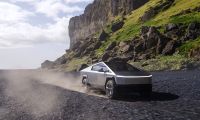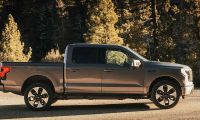Here’s a run down of the relatively minor things that bother me about my Sorento PHEV. First, though relatively minor, I find it annoying that Kia does not include more information about my driving patterns in its various displays and cumulative info screens. Specifically, I would like to know for any given drive at least (if not cumulatively since mile 0) how many miles have been driven on electricity versus gasoline. To be honest, I don’t know that many plug-in hybrids show precisely this information, cumulatively or otherwise, but my Chevy Volt at least showed it per drive and if the Kia could do at least that much, I’d be satisfied. It shouldn’t be terribly difficult for Kia’s software teams to calculate and display a total, cumulative split of miles on battery vs miles on gasoline. Kia must realize that a significant number of customers that buy PHEVs are data nerds and keenly interested in knowing just how much or how little they are burning gas (or so my selfish, me first, you must not really be Gen X personality tells me). Granted, one can roughly estimate these things by using the following 3 screens that Kia does provide.
First the Accumulated Info screen shows you, for up to the last 9,999 miles, what your accumulated MPG is. The higher that number is, the more you’re driving on electricity. After 4,348 miles I have driven approximately 55% on electricity (I keep my own log; did I mention I’m a data nerd?), and my MPG in the Accumulated Info screen is about 65 MPG. That is after multiple long road trips earlier this year; just before I started that series of long trips my MPG was 110 and 73.5% electric, so if you have a number north of the upper 50’s MPG in this screen, you may be driving on electricity at least 50% of the time, and over 100 MPG should mean 70% or more.

For either your current drive, or since the last time you filled your gas tank, the Drive Info and Since Refueling screens, respectively, will give you an idea of how much of your driving has been on electricity vs gas more recently. In Drive Info (which resets every time you turn the car off) if the Avg MPG value is 999, that means you are driving on 100% electricity. In the Since Refueling screen, the same is true, however eventually the Sorento PHEV has to burn some gas either for fuel maintenance or simply because you have exhausted the battery. So any number less than 999 means you have driven on gas at some point, and the higher the number the less the gas powered distance, since refueling/turning off the car. Whew! Confused yet? It’s a lot to keep track of and Kia should really just make it easier on us, or at least on nerdy number crunchers like me anyway! Note, apparently Kia resets the Accumulated Info figure at 10k miles (or kilometers too, I assume) and so one needs to keep track of that figure elsewhere and then average it over time, if you want full history.
What else bugs me? It’s a pretty short list really, because overall the Sorento PHEV is just a fantastic sport utility vehicle capable of outstanding fuel efficiency given its size and weight. I wish the hybrid battery was a little larger (16-18 kWh) so that it could better support: a more powerful electric motor (120-140 ponies would be nice, instead of 90; who doesn’t love ponies!), more EV miles, and a “deeper” pedal travel to make it easier to keep it in EV mode. Also, I would appreciate a little different throttle mapping, or some other adjustment to the transmission/gearing to avoid the throttle hesitation that often happens when slowing down to a near stop, but not stopping fully. Coming to a full stop before pressing down on the accelerator seems to bypass this issue, and that’s great, but not in traffic and especially on hills. This hesitation makes it easy to kick the PHEV’s gas motor on and creates more “rubber banding” as suddenly the electric motor puts out its max output and the vehicle lurches forward but may roll back before doing so.
What about you? Have you driven the Sorento PHEV? Do you have any peeves toshare? Any feedback for Kia you wish they’d listen to? Leave your responses or questions below.
Images provided by Jusitn Hart.
Justin Hart has owned and driven electric vehicles for over 14 years, including a first generation Nissan LEAF, second generation Chevy Volt, Tesla Model 3, an electric bicycle and most recently a Kia Sorento PHEV. He is also an avid SUP rider, poet, photographer and wine lover. He enjoys taking long EV and PHEV road trips to beautiful and serene places with the people he loves. Follow Justin on Twitter for daily KIA EV news coverage.













Comments
Hi Justin, I live in Canada
Permalink
Hi Justin, I live in Canada and was lucky to get my PHEV in November, so I drove it sub 0 conditions. I'd like for Kia to improve the way the Sorento behaves in/handles cold weather: even though most of my daily driving is slow (within neighborhoods) the ICE gets fired up to warm up the engine just in case I suddenly need the power, translating into a not so great gas consumption. So basically add a heat pump or a driving mode that overrides the need to heat the ICE.
Thoughts?
I'm interested in your
Permalink
In reply to Hi Justin, I live in Canada by Juan David Rojas (not verified)
I'm interested in your comments and Justin's response. I just ordered the phev Sorento, and being a new product, no dealer people knew, nor were Kia's information clear on EV mode driving. I assumed I'd be able to drive until the battery discharged before the ICE would start, but you're saying that it will start randomly while in EV mode. Also that there is only the ICE to heat the cabin in our NY winters. This is not good, and I'll likely cancel my order. On my 20 mile daily run, if the ICE has to run a few minutes for cabin heat in winter, also apparently on the long hill I have that you say the electric motor may not be strong enough for, then what's the point of saying it's a 33 mile range ev. Plus it seems like the ICE may not get warmed up enough in winter in my driving cycle to prevent the exhaust condensation and its associated issues. Can you, or you Jason, confirm?
@R Kurtz: ICE is not starting
Permalink
In reply to I'm interested in your by R Kurtz (not verified)
@R Kurtz: ICE is not starting randomly. Basically the trigger is demand on power or heating. My observation is, that the EV is dynamic enough in city and can keep highway speed without problem (but drains battery much faster). Where it lacks is when you would like to get to the highway speed quickly - for example when joining highway. If you don't want to see ICE here, you need to be patient with acceleration, which could be bothering. For the heating - until some point, especially if I'm alone in car, I do most winter commute in EV mode using seat and steering wheel heating only. For longer journey, I use normal heating where heat comes from ICE. When ICE is started only due heating demand, it works like generator and charges your battery while in EV mode and not really using the ICE as power source for driving. So you still have better MPG, but yes, not without burning some gas. And what annoys me is when it kicks the ICE on on summer morning just because actual temperature is 2 degrees lower than the one I set on AC last day...
@Justin Hart: agree, there should be a bit more statistics provided by KIA. I would like to see average and total electric consumption for my rides. There is only graph in PHEV section - ECO driving - but is useless as for anything higher than 15kWh/100km shows just 15kWh (btw - in online manual for infotainment, I see screen where electric consumption per ride is displayed, in my case only fuel consumption visible there). As well in History there are no rides where only EV mode was in use. It waits for first sip of gasoline and then adds all the EV km's from past rides to new record. And last annoying bit is unpredictable behavior of planned charging. It get better with last software update, but still some times it ignores programmed schedule.
There was already several sw updates, each came with some improvements, so hopefully in next one this will be fixed :-) Otherwise the car is great and I'm happy I select it. Plenty of space, lot's of safety and comfort features, very ecological for my daily EV commute and when I need power to overtake on steep narrow roads, there is enough to do it safely.
I couldn’t agree more Jan!
Permalink
In reply to @R Kurtz: ICE is not starting by Jan (not verified)
I couldn’t agree more Jan! Kia’s software seems, to me, to need the most work of anything. I find the app for controlling the car to be all but useless (when it even works). I definitely won’t be paying for it when my free subscription expires in about a week. Their in car software is better, but still, needs improvement as you suggested. I wonder, might you control your charging time with your EVSE (the charging cable you plug into your Kia) or perhaps by installing an external timer? I don’t worry about or use timed charging because my electricity rates are always the same, but I would be highly annoyed by that, if I did need to charge only at certain times.
I'm using smart EVSE capable
Permalink
In reply to I couldn’t agree more Jan! by JustinHart (not verified)
I'm using smart EVSE capable of 22kW (AC) max charring power (from which Kia can use sadly only 3.6kW). Device itself is capable of planned charging times, but the company who installed it, want's some (not small) monthly fee for enabling that services, which I never took as an option. If I charge in off peak time, my bill is less than half of normal price, so when possible, I try to schedule the car to use this off peak hours. If all works 100% reliable in KIA software, then I'm happy with the scheduling option they provide in car or through the app. Just there is still this little bit of tuning needed to improve it.
Yes, if only Kia would “fine
Permalink
In reply to I'm using smart EVSE capable by Jan (not verified)
Yes, if only Kia would “fine tune” the scheduled charging feature in their app. I have no need for it, as my electricity rates are the same at all times, but the one time I tried it to test it out, it didn’t work. Maybe it was just a fluke, on my part? I’ll have to try it again….
R Kurtz, you may want to
Permalink
In reply to I'm interested in your by R Kurtz (not verified)
R Kurtz, you may want to review my response to the other posts here too, but in winter it is difficult to get the same range you would get in the warm months. I am getting about 40-43 miles per charge in the summer in Seattle, typically, in mixed suburban and freeway driving conditions, and in winter I am getting between 33 and 36 miles of range. But I drive my Kia Sorento “easy” almost all the time (and save my sportier driving for my Tesla Model 3) as I am trying to extract as much efficiency as I can out of it. The “problem” with heating is that using batteries for heat is “wasteful”… yes heat pumps work (though I hear not as well in temps that are well below freezing), but one will use up to 30% of their range for heat if doing that (and add additional heat stress to the battery, potentially). If you don’t mind your Kia only getting about 20 miles of EV range in the winter, maybe that’s a trade off you’d prefer? I think what Kia is ultimately trying to do is deliver the stated range (or better) in a greater variety of conditions. My Tesla can get over 300 miles on a charge for example, but the only way I am going to get that is at an average speed of 45 MPH or less on a relatively warm day (say warmer than 65 degrees). I’ll see more like low 200’s in the winter if I am mostly driving on the freeway (and then only if I drive the speed limit and don’t push the car too hard).
I actually asked Kia about
Permalink
In reply to Hi Justin, I live in Canada by Juan David Rojas (not verified)
I actually asked Kia about this, and this was their reply: “ Kia’s plug-in vehicles – including Sorento PHEV, EV6, and Niro EV and PHEV - use a separate high-voltage battery heating and cooling circuit that is specifically engineered to manage the high-voltage battery’s temperature. For the PHEVs, considering their smaller battery size versus our EVs, the size of the battery heating/cooling circuit is unlikely to provide sufficient heat needed to properly heat the car’s cabin. Therefore, for PHEVs, heat generated from the I.C.E. is used to heat the cabin.” So, basically, Kia is telling us that for PHEVs, they don’t use the battery for cabin heat because of the size of their batteries/the efficiency of doing so was not adequate or “not likely to provide sufficient heat…”. My 2017 Chevy VOlt, which has about 5 additional kWh of battery capacity, used a resistive electric heater, but could also utilize heat from the gas engine, when in use. I also think that is a better design, but I do understand Kia’s logic here: their batteries are “just” big enough to provide the intended functionality (i.e. around 32 miles of range in their SUVs) and they would 1. use up to about 30% of battery capacity for heating if they used the battery for heat (resistive heat mind you, not a heat pump) 2. their vehicles would be more expensive, with the addition of an electrical heating system and a larger battery to offset (and perhaps more robust battery cooling apparatus to deal with the additional load, heat pump or otherwise). 3. since you’re going to get less range in cold weather (especially extreme cold weather) it increases the likelihood of needing the gas engine anyway, so the logic of adding more expense and weight to the vehicle sort of holds up. My suggestion: the Sorento PHEV “idles” the engine for heat; you might want to experiment with just using the heat vs. putting the car into HEV or Sport mode at the start of your drive, depending on the distance of your drive, and then switching to EV mode after the engine has warmed up and seeing if that residual heat plus seat heaters/steering wheel are adequate to get you to your destination. That, or consider getting a full EV or a plug-in hybrid vehicle with a larger battery the next time you are in the market… as I am afraid Kia’s design may not be optimal for those trying to best reduce gasoline use and who live in regions where lengthy period of sub freezing temperatures are the norm. I realize, that last part isn’t much comfort, but hopefully you might at least find some better results/get better efficiency “playing with” the modes to warm up your engine faster than just idling it when you turn on the heat.
I bought my Kia Sorento…
Permalink
In reply to I actually asked Kia about by JustinHart (not verified)
I bought my Kia Sorento several months ago and this is the one thing that really bothers me. Once it started getting colder (I’m in the Seattle area too but we don’t get extreme weather) and I used the heater the EV MPG wasn’t getting what it was before. It took me a few days to figure out and realized it was once I turned the heater on, even though it says it’s in EV mode and my battery is charged it’s using gasoline and the EV MPG is going down. Lately I’ve been using the seat and steering wheel heat but even if I need to defrost the window, once I turn that on the EV stops working. If I turn it off after a minute to defrost it still doesn’t work. I have to pull over, turn off the car and turn it back on to get the EV to work properly. Do all EV/Hybrids work like this? We looked at the Volvo XC90 and I wonder if it does the same thing? Going to research that next. We are extremely unhappy and feel like Kia really misrepresented the Sorento as we bought it for the EV portion but wanted the hybrid for longer trips. As my day to day driving is short so I only plug in every few days.